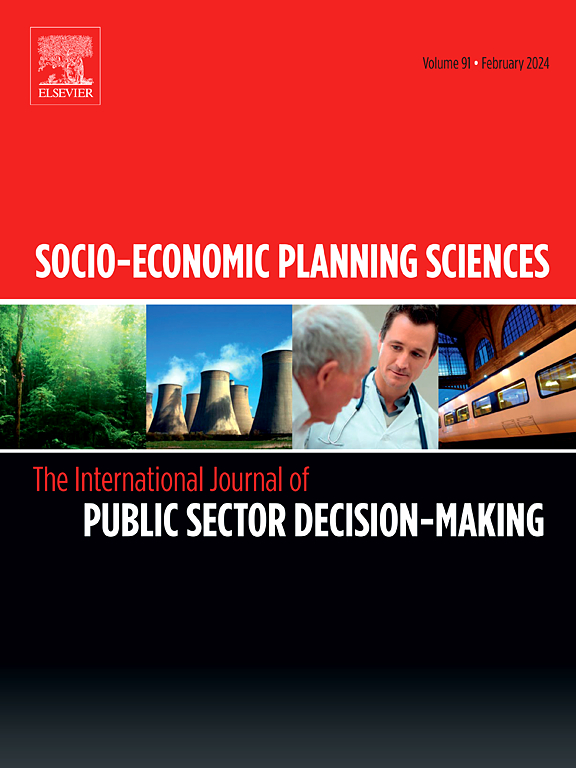Demand information disclosure in fresh produce supply chain considering competition between geographical indication and local suppliers
IF 6.2
2区 经济学
Q1 ECONOMICS
引用次数: 0
Abstract
When geographical indication fresh produce (GIFP) enters a distant market, demand uncertainty complicates the operational decisions for both the GIFP supplier (GS) and the local fresh produce supplier (LS), whereas the retailer disclosing demand information helps suppliers make optimal decisions. This study aims to explore the impacts of information disclosure on the retailer, GS, and LS and study the information disclosure strategy in the fresh produce supply chain (FPSC). We construct a multistage game model to investigate the retailer's optimal information disclosure decisions and demonstrate the validity of the results through a case study. Furthermore, we develop information contracts to prompt information collaboration in the FPSC. The results show that both the GS and the LS are willing to receive information, whereas the retailer chooses to disclose it voluntarily only when the freshness elasticity is not too low. Moreover, with the improvement in freshness elasticity, the retailer should first disclose to the GS and then to both the GS and LS and finally shift back to the GS. The influences of information disclosure on the performance of the supply chain are relevant to both the freshness elasticity and the quality advantage of the GIFP. Additionally, we identify three scenarios where supply chain performance can be improved by adjusting the retailer's disclosure strategy and propose corresponding contracts on the basis of information fees. This study provides actionable strategies for FPSC stakeholders.
考虑地理标志与本地供应商竞争的生鲜农产品供应链需求信息披露
当地理标志新鲜农产品(GIFP)进入一个遥远的市场时,需求的不确定性使GIFP供应商(GS)和当地新鲜农产品供应商(LS)的经营决策复杂化,而零售商披露需求信息有助于供应商做出最优决策。本研究旨在探讨信息披露对零售商、GS和LS的影响,研究生鲜农产品供应链(FPSC)中的信息披露策略。本文构建了一个多阶段博弈模型来研究零售商的最优信息披露决策,并通过实例验证了结果的有效性。此外,我们制定了信息合同,以促进FPSC的信息协作。结果表明,GS和LS都愿意接受信息,而零售商只有在新鲜度弹性不太低的情况下才会选择自愿披露信息。而且,随着新鲜度弹性的提高,零售商应该先向GS披露,然后同时向GS和LS披露,最后再向GS披露。信息披露对供应链绩效的影响既与GIFP的新鲜度弹性有关,也与GIFP的质量优势有关。此外,我们确定了通过调整零售商的披露策略可以改善供应链绩效的三种情况,并提出了基于信息费的相应合同。本研究为FPSC利益相关者提供了可操作的策略。
本文章由计算机程序翻译,如有差异,请以英文原文为准。
求助全文
约1分钟内获得全文
求助全文
来源期刊

Socio-economic Planning Sciences
OPERATIONS RESEARCH & MANAGEMENT SCIENCE-
CiteScore
9.40
自引率
13.10%
发文量
294
审稿时长
58 days
期刊介绍:
Studies directed toward the more effective utilization of existing resources, e.g. mathematical programming models of health care delivery systems with relevance to more effective program design; systems analysis of fire outbreaks and its relevance to the location of fire stations; statistical analysis of the efficiency of a developing country economy or industry.
Studies relating to the interaction of various segments of society and technology, e.g. the effects of government health policies on the utilization and design of hospital facilities; the relationship between housing density and the demands on public transportation or other service facilities: patterns and implications of urban development and air or water pollution.
Studies devoted to the anticipations of and response to future needs for social, health and other human services, e.g. the relationship between industrial growth and the development of educational resources in affected areas; investigation of future demands for material and child health resources in a developing country; design of effective recycling in an urban setting.
 求助内容:
求助内容: 应助结果提醒方式:
应助结果提醒方式:


